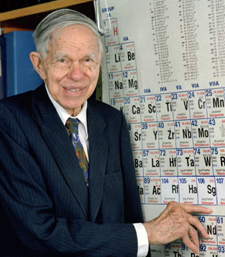90th Anniversary Issue: 1940s
The Atomic Age, elementary finds and other highlights, 1940–49

Mushroom clouds usher in atomic age
Less than three years separated the first self-sustaining nuclear chain reaction on December 2, 1942, and the production and use of the first nuclear bombs against Hiroshima and Nagasaki (above). In 1946, weapons tests at Bikini Atoll — some witnessed by embedded Science News Letter reporters (7/13/46, p. 22; 8/3/46, p. 67; 8/10/46, p. 84) — brought home the field-acquired details of long-lasting mutation risks. At the end of the decade President Truman announced, “We have evidence that within recent weeks an atomic explosion occurred in the U.S.S.R.,” launching what would come to be known as the nuclear arms race. The president offered no details, but Science News Letter explained how such surreptitious weapons tests could have been identified and authenticated (10/1/49, p. 211). — Janet Raloff
Note: N indicates findings that went on to win a Nobel Prize.
1940 | Radar for planes David G.C. Luck describes radar and it potential use in plane navigation (7/13/40, p. 29).
1940 | Lascaux cave art French schoolboys call anthropologists’ attention to 30,000-year-old prehistoric cave art (above) in Lascaux in late 1940 (2/8/41, p. 85).
1941 | Carbon dating Radiocarbon tracers for medicine using carbon-14 are reported (3/15/41, p. 163), and scientists describe the use of carbon for dating objects more than 20,000 years old (3/12/49, p. 171). N
1942 | Nuclear reaction The first human-controlled self-sustaining nuclear chain reaction takes place on December 2, 1942, at the University of Chicago’s Stagg Field (12/6/52, p. 358).
1943 | Epidural magic Details of an epidural nerve block that allows pain-free childbirth without putting women to sleep are reported (1/30/43, p. 67).
1944 | Toxic pesticides Data begin to show that DDT and other widely used pesticides, while effective, could prove toxic to people and other animals (8/5/44, p. 90; 11/11/44, p. 310; 12/23/44, p. 402).
1945 | Bombing Japan The United States drops two nuclear bombs on Japan (8/18/45, p. 102, 103).
1945 | Autism Leo Kanner reports on his studies of a mental illness in 20 children that causes them to largely ignore the people around them, a disease that would come to be called autism (8/11/45, p. 92).
1946 | Bikini bombing Stories predict what the coming Bikini Atoll nuclear tests would do to ships and the local environment (2/2/46, p. 78; 2/23/46, p. 116; 5/11/46, p. 294; 6/1/46, p. 346; 6/22/46, p. 394; 7/6/46, p. 3).
1946 | ENIAC computer The University of Pennsylvania rolls out the first all-electronic general-purpose digital computer (left), called ENIAC (2/23/46, p. 118).
1947 | Chemical mutation Experiments in mice show that chemicals can — like radiation — induce mutations (1/11/47, p. 20).
1947 | Quartz clock The U.S. National Bureau of Standards reports timekeeping accurate to a millionth of a second using quartz crystals (1/11/47, p. 22).
1947 | Transistor Transistors (first one shown below) could replace vacuum tubes (7/10/48, p. 19). N
1948 | Photosynthesis Scientists lay out the steps of photosynthesis (1/10/48, p. 19; 4/17/48, p. 243). N
1949 | DNA DNA is identified “positively” as the constituent of genes (2/5/49, p. 83).
 Elementary finds stack up
Elementary finds stack up
Throughout the history of Science News, scientists have steadily expanded the periodic table — from hafnium, element number 72 (3/3/23, p. 4), to element 117, temporarily called ununseptium (4/24/10, p. 15). Along the way were surprises: For example, finding illinium (later replaced by promethium) did not leave just two more elements to discover, as initially claimed in 1926.
In 1951, Glenn T. Seaborg (shown) and Edwin McMillan shared the chemistry Nobel for using atom smashers to create six elements and some 100 new isotopes (11/24/51, p. 323). Seaborg and his team would go on make many more discoveries (covered in nine follow-up stories). For these achievements, Seaborg was honored by having element 106 named for him (3/19/94, p. 180) — a decision that was unsuccessfully contested (10/22/94, p. 271; 4/12/97, p. 228).
Seaborg’s gangly frame and wide smile were familiar to Science News staffers, as he ambled down office hallways several times a year. From 1966 to 1995, he chaired the board of trustees for Science News’ parent organization, now known as Society for Science & the Public. He was the first of three Nobelists to do so, and one of eight laureates to serve on the board. — Janet Raloff
Lawrence Berkeley National Lab/flickr







